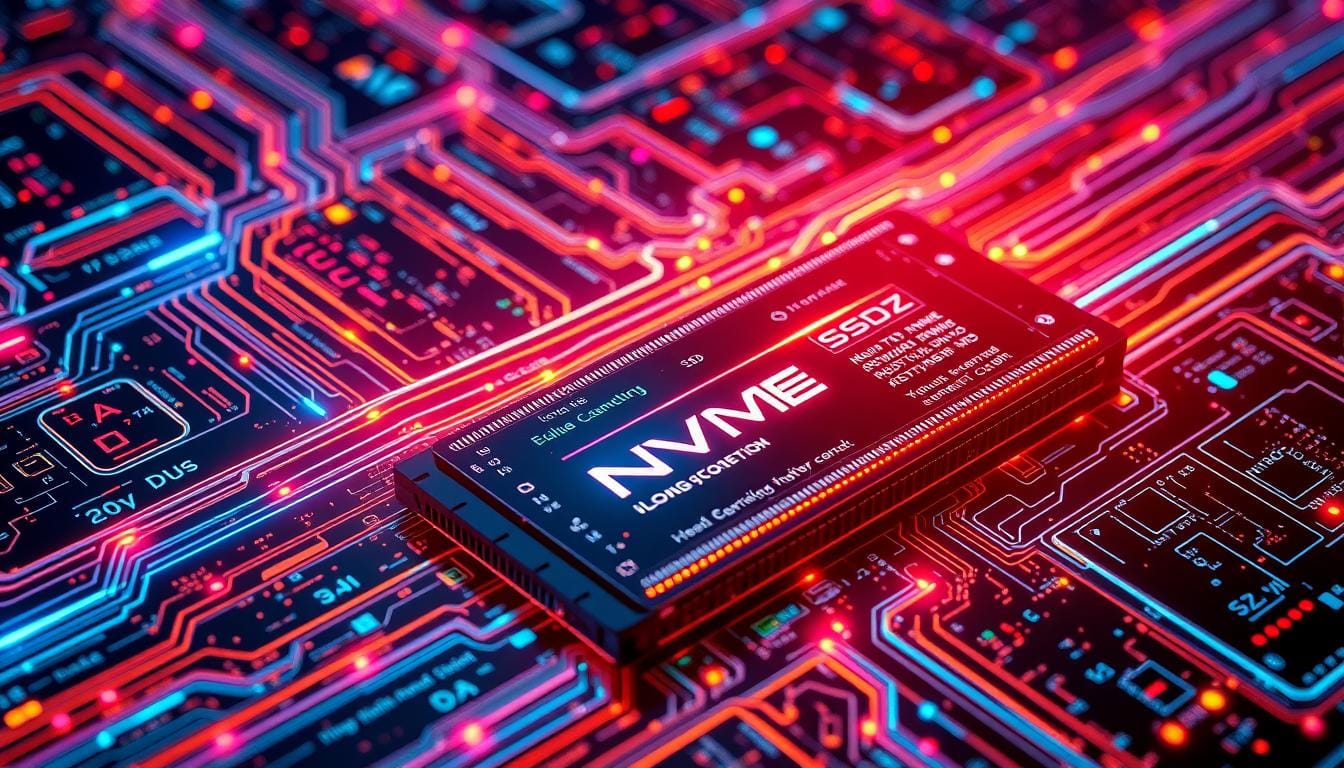The rise of artificial intelligence (AI) and machine learning (ML) has changed how we handle data. NVMe (Non-Volatile Memory Express) solid-state drives (SSDs) are now the top choice for these tasks. They are favored by both big and small businesses for AI and ML needs.
Today’s machine learning training datasets can be huge, like terabytes. They might include thousands or even hundreds of thousands of images. For these tasks, local NVMe drives must offer both high speed and quick access, essential for training.
Key Takeaways
- NVMe SSDs have become the preferred storage solution for AI and ML workloads, providing high bandwidth and low latency
- Modern AI and ML datasets can reach terabytes in size, requiring fast and scalable storage solutions
- NVMe SSDs can speed up machine learning training by up to 10x and boost GPU use
- Pogo Linux servers can benefit from low-latency and high-throughput NVMe storage for AI and ML applications
- The latest NVMe SSD models offer a lot of capacity and performance for AI and ML use cases
Storage Challenges in AI and ML Workloads
Enterprises dealing with AI and ML face big storage hurdles. Handling the huge datasets for training models is tough, as data grows fast. Also, local SSDs in GPU nodes have small capacities, slowing down these powerful tools.
Organizations also face latency issues that affect AI and ML performance. Old storage solutions can’t meet the needs of today’s AI and ML apps. This leads to bottlenecks that slow down these advanced technologies.
| Storage Challenges | Impact on AI/ML Workloads |
|---|---|
| Data Capacity Limitations | Inability to accommodate large datasets for model training |
| Data Processing Bottlenecks | Reduced GPU utilization and suboptimal model performance |
| GPU Utilization Issues | Inefficient leveraging of powerful computing resources |
To solve these storage problems, companies are looking at new solutions. Non-volatile memory express (NVMe) SSDs are becoming popular. They provide the speed, scalability, and reliability needed for AI and ML.
Benefits of NVMe SSDs for AI and ML
NVMe (Non-Volatile Memory Express) SSDs bring big advantages for AI and ML. They offer more bandwidth and lower latency than old storage tech. This means they can handle demanding AI tasks better.
NVMe SSDs have 64,000 queues. This lets them manage up to 64,000 data requests at once. It boosts their performance even more.
For AI and ML, NVMe tech can feed data at up to 16 GBps per GPU. This greatly improves how fast things run. With huge data sets, NVMe storage is key to keep things running smoothly.
Using NVMe SSDs is vital for AI training, even with top GPUs or special chips. It makes sure GPUs are always working hard. This is because they get data quickly, making them more efficient.
Choosing the right NVMe SSD is important. It depends on the AI app’s storage needs. Some AI tasks need more reading than others.
NVMe SSDs have big advantages over old storage for AI and ML. They offer better bandwidth, lower latency, and can handle lots of tasks at once. This makes them key for speeding up AI and ML systems.
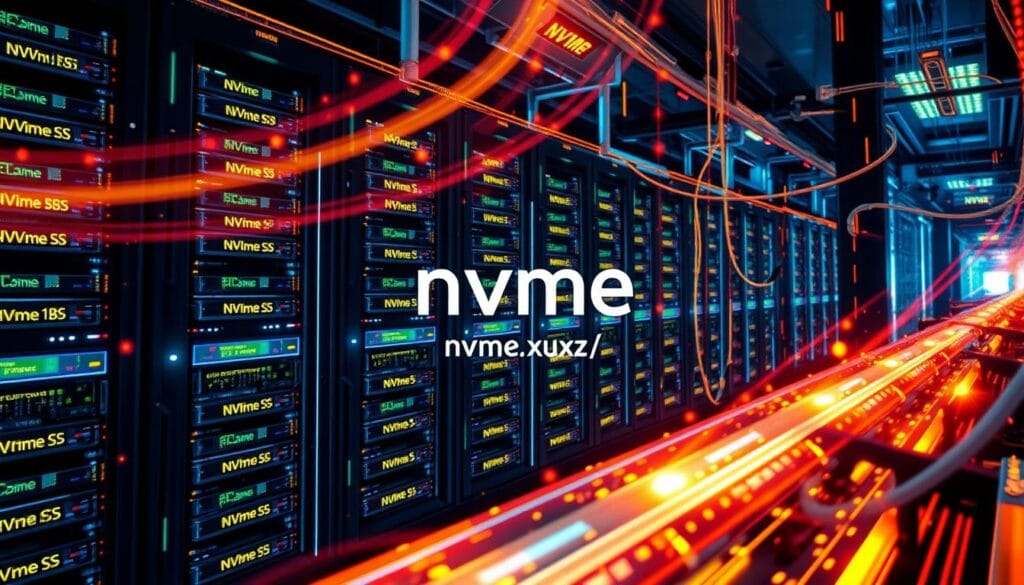
Accelerating AI and ML Training with NVMe Storage
Storage is key when training AI and ML models. The most time-consuming part is model training. It needs fast storage to keep GPUs busy. NVMe SSDs are perfect for this, speeding up the training.
NVMe SSDs are great for AI and ML. They have very low latency, which is vital for keeping GPUs working. They also offer high bandwidth, allowing for smooth data flow to the processing units.
| Performance Metric | Improvement with KIOXIA CM7-R Series SSD |
|---|---|
| Maximum Drive Training I/O Throughput | Up to 91% higher |
| Average Drive Read Latency | Up to 57% lower |
| Average Accelerator Utilization | Up to 14% higher |
| Training Sample Processing Throughput | Up to 13% higher |
| Average Drive Training I/O Throughput | Up to 13% higher |
| Total Time to Complete Training | Up to 12% lower |
NVMe SSDs greatly improve AI and ML training efficiency. For instance, the KIOXIA CM7-R Series SSD made training 12% faster. This could save about 44 days of training per year. It also keeps accelerators busy, making training more efficient.
Using NVMe storage’s low latency, high bandwidth, and parallel data access, organizations can speed up AI and ML training. This leads to quicker model development, better decision-making, and improved business outcomes.
Scalability and Performance of NVMe in AI/ML Clusters
The need for storage solutions has grown fast with AI and ML. NVMe SSDs are perfect for AI and ML clusters because they scale well and perform well.
GPUs are now key in AI/ML clusters because they work in parallel better than CPUs. But, they need fast storage to handle all the data.
Shared NVMe storage is a great fix for AI/ML clusters. It helps with parallel processing and supports deep neural networks. NVMe storage also cuts down latency, making it as fast as local SSDs.
NVMe storage also scales up well. The data needed for AI and ML grows fast. By 2020, each internet user will create 1.7 MB of data. NVMe can handle petabytes of data, meeting the growing needs.
As more storage is added, NVMe’s performance keeps getting better. It avoids the slowdowns of older storage systems. NVMe’s design lets AI and ML workloads use all the storage they need, making the cluster more efficient.
| Storage Protocol | Command Queue Depth |
|---|---|
| SATA | 32 |
| SAS | 256 |
| NVMe | Up to 64K |
NVMe storage is key for making AI and ML clusters work better. It helps these demanding tasks run smoothly and quickly.
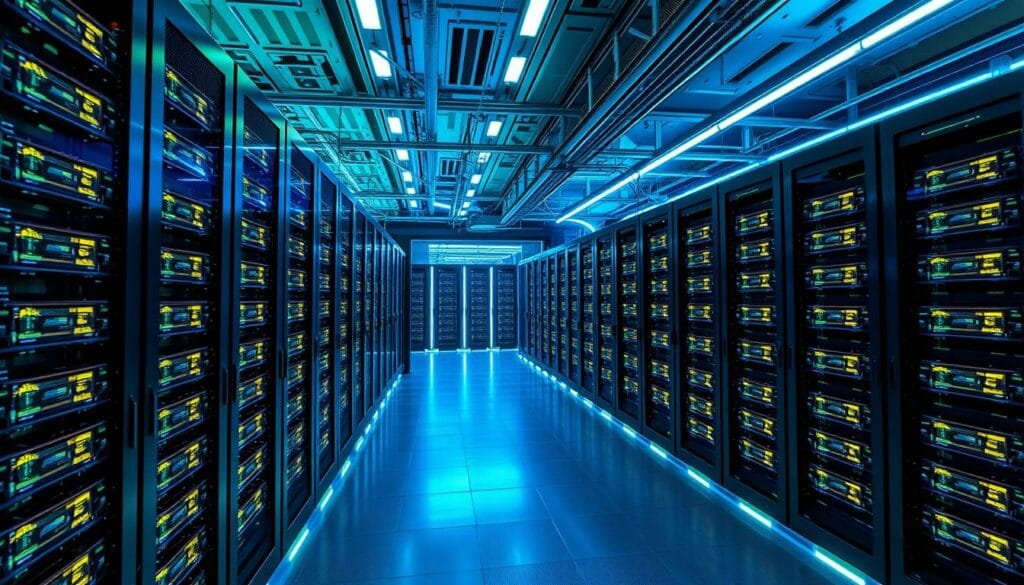
Choosing the Right NVMe SSD for AI and ML Workstations
Choosing the right storage is key for AI and ML workstations. NVMe SSDs are the top choice. They offer great performance and grow with your needs.
AI and ML models are getting bigger and more data-driven. NVMe SSDs are perfect for handling big workloads. They are much faster than old SSDs, making training and data processing quicker.
When picking an NVMe SSD, look at speed, capacity, and security. The WD Ultrastar DC series NVMe SSDs and the Samsung PM9A3 NVMe PCIe 4.0 SSD are great. They offer top performance, lots of storage, and strong security.
| SSD Model | Capacity | Sequential Read/Write | Random Read/Write | Endurance |
|---|---|---|---|---|
| WD Ultrastar DC SN840 | 800GB – 7.68TB | 6,400 / 3,000 MB/s | 800K / 160K IOPS | 3 DWPD |
| Samsung PM9A3 | 1TB – 8TB | 7,000 / 5,000 MB/s | 1M / 220K IOPS | 1.4 DWPD |
By looking at your needs, you can pick the best NVMe SSD. This ensures your AI and ML workstations run smoothly and efficiently.
“NVMe SSDs are transforming the way we approach AI and ML workloads, providing unparalleled performance and scalability to meet the demands of these data-intensive applications.”
Optimizing Storage Configurations for AI and ML
Enterprises face growing storage needs for AI and ML. They use a tiered storage method. This method includes fast NVMe SSDs for active data and a bigger, cheaper storage for less used data.
NVMe’s low latency helps speed up tasks like video streaming and scientific simulations.
Solutions like Samsung’s Disaggregated Storage System (DSS) improve storage setups. It turns storage into a networked pool, removing bottlenecks and boosting SSD performance. NVMe also supports multiple queues, helping multitasking workloads.
NAS systems are great for AI and ML, providing a centralized, scalable storage solution. They separate storage from compute, making infrastructure more flexible and cost-effective. NVMe ensures data safety with end-to-end protection and error correction.
As AI and ML grow, optimizing storage is key. Using NVMe SSDs, tiered, and disaggregated storage unlocks AI and ML’s full power. This leads to big business wins.
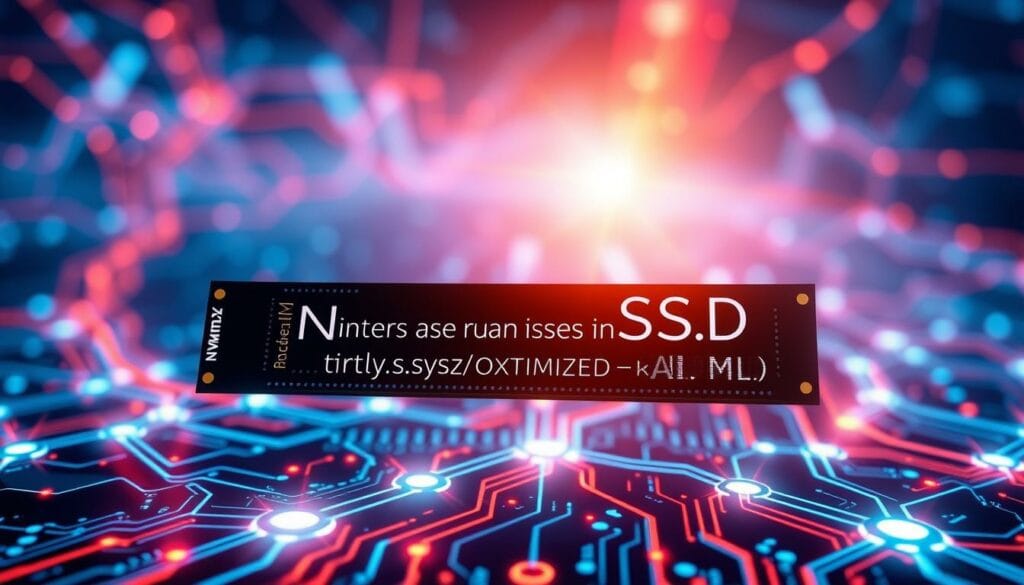
Real-World Applications of NVMe SSDs in AI and ML
NVMe SSDs are changing how we use Artificial Intelligence (AI) and Machine Learning (ML) in many fields. They make data processing faster and more efficient. This opens up new possibilities that were once thought impossible.
In predictive maintenance, NVMe SSDs are key. They help IT teams quickly access big data for analysis. This fast storage helps find problems early and fix them before they cause trouble. It makes systems run smoother and saves time.
NVMe SSDs also make customer experiences more personal. They allow for quick data processing and AI decisions. Banks use them to spot fraud fast and make loans more efficiently. This means better service and safety for customers.
In healthcare, NVMe SSDs speed up medical image analysis. They help doctors quickly review X-rays and MRI scans. This leads to faster and more accurate diagnoses, which is good for patients.
In manufacturing, NVMe SSDs help make production better and safer. They let AI systems quickly check sensor data. This helps find problems and suggests ways to improve, making things safer and more efficient.
“The combination of NVIDIA’s GPUDirect Storage and Micron’s data center SSDs accelerates AI solutions, boosting productivity and performance in AI applications.”
The need for fast data processing and AI decisions is growing. NVMe SSDs will play a bigger role in making these solutions work. They help businesses in many fields work better, be more personal, and innovate more. This is setting the stage for a future where AI and ML are part of our daily lives.
Emerging Storage Technologies for AI and ML Workloads
New storage technologies are emerging to meet the growing demands of artificial intelligence (AI) and machine learning (ML). Persistent memory, computational storage, and storage class memory are promising. They can work with NVMe SSDs to offer lower latency, higher bandwidth, and more processing power.
Persistent memory is like non-volatile storage that’s fast like DRAM. It lets AI and ML models work on data without moving it around. Computational storage puts processing power in the storage device. This offloads tasks from the CPU, speeding up AI and ML workloads. Storage class memory is a mix of DRAM’s speed and NAND flash’s persistence. It gives ultra-low latency access to important data.
These new technologies, along with NVMe SSDs, are changing how AI and ML workloads are handled. They bring processing power closer to the data and cut down on latency. This makes AI and ML more efficient and effective, leading to faster insights and more accurate predictions.,,
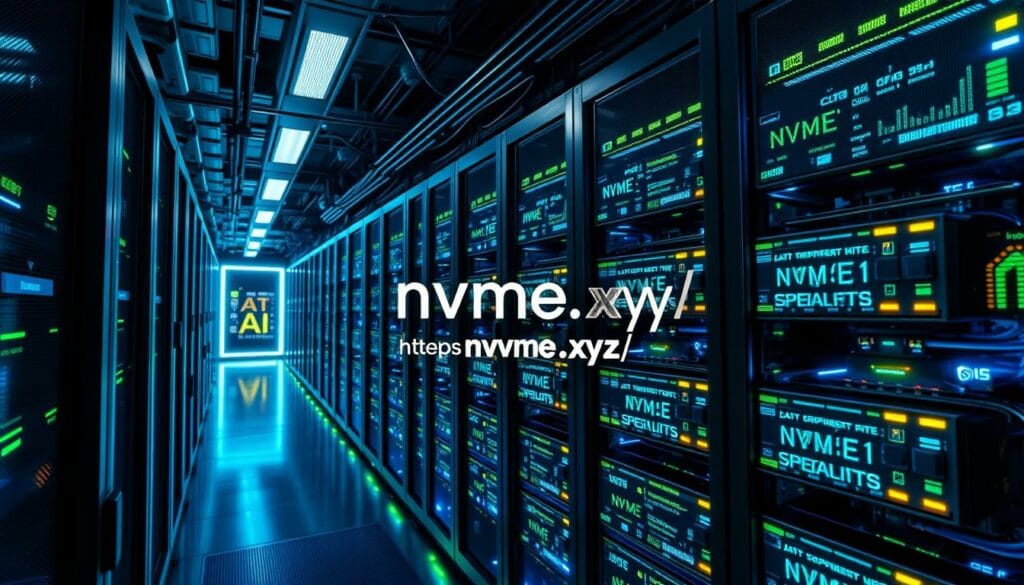
“The innovative HPE Alletra 4110 data storage server delivers exceptional storage performance and capacity density with industry-leading technologies like PCIe Gen 5 connected NVMe and low-latency high-speed networking.”
Persistent Memory for AI and ML
Persistent memory, or non-volatile memory (NVM), is fast and keeps data. It’s accessed at memory speeds, giving AI and ML models quick access to data without the delay of moving it.
Computational Storage for AI and ML
Computational storage adds processing power to the storage device. It moves data-intensive tasks from the CPU. This frees up resources for other important AI and ML computations.,
Storage Class Memory for AI and ML
Storage class memory is a mix of DRAM’s speed and NAND flash’s persistence. It offers ultra-low latency access to data. This boosts AI and ML performance, enabling faster processing and real-time decision-making.
As AI and ML demand grows, these new storage technologies, along with NVMe SSDs, are key. They bring processing power closer to the data and reduce latency. This leads to faster insights, more accurate predictions, and greater business value.,
Conclusion
The world of artificial intelligence (AI) and machine learning (ML) is growing fast. High-performance storage solutions play a key role in this growth. NVMe SSDs are now essential, helping businesses use data-intensive workloads to innovate in many fields.
NVMe SSDs offer unmatched speed and low latency. This has changed how AI and ML models are trained and used. They help businesses manage big data, speed up model training, and use GPUs better.
As more businesses use AI and ML, they need better storage. NVMe SSDs are ready to meet this need with their top-notch performance and efficiency. They will help drive the next big steps in AI and ML breakthroughs.
NVMe technology will keep getting better, meeting the needs of data-heavy workloads. Businesses that use NVMe storage will be ahead of the game. They’ll be ready to use these new technologies to stay competitive.
“NVMe SSDs have become the backbone of the AI and ML revolution, enabling businesses to unlock new levels of performance, efficiency, and innovation.”
